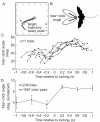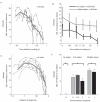Active control of acoustic field-of-view in a biosonar system
- PMID: 21931535
- PMCID: PMC3172196
- DOI: 10.1371/journal.pbio.1001150
Active control of acoustic field-of-view in a biosonar system
Abstract
Active-sensing systems abound in nature, but little is known about systematic strategies that are used by these systems to scan the environment. Here, we addressed this question by studying echolocating bats, animals that have the ability to point their biosonar beam to a confined region of space. We trained Egyptian fruit bats to land on a target, under conditions of varying levels of environmental complexity, and measured their echolocation and flight behavior. The bats modulated the intensity of their biosonar emissions, and the spatial region they sampled, in a task-dependant manner. We report here that Egyptian fruit bats selectively change the emission intensity and the angle between the beam axes of sequentially emitted clicks, according to the distance to the target, and depending on the level of environmental complexity. In so doing, they effectively adjusted the spatial sector sampled by a pair of clicks-the "field-of-view." We suggest that the exact point within the beam that is directed towards an object (e.g., the beam's peak, maximal slope, etc.) is influenced by three competing task demands: detection, localization, and angular scanning-where the third factor is modulated by field-of-view. Our results suggest that lingual echolocation (based on tongue clicks) is in fact much more sophisticated than previously believed. They also reveal a new parameter under active control in animal sonar-the angle between consecutive beams. Our findings suggest that acoustic scanning of space by mammals is highly flexible and modulated much more selectively than previously recognized.
Conflict of interest statement
The authors have declared that no competing interests exist.
Figures




Comment in
-
Bats broaden sonar field of view to maneuver around obstacles.PLoS Biol. 2011 Sep;9(9):e1001147. doi: 10.1371/journal.pbio.1001147. Epub 2011 Sep 13. PLoS Biol. 2011. PMID: 21931532 Free PMC article. No abstract available.
Similar articles
-
Bats adjust their mouth gape to zoom their biosonar field of view.Proc Natl Acad Sci U S A. 2015 May 26;112(21):6724-9. doi: 10.1073/pnas.1422843112. Epub 2015 May 4. Proc Natl Acad Sci U S A. 2015. PMID: 25941395 Free PMC article.
-
Click-based echolocation in bats: not so primitive after all.J Comp Physiol A Neuroethol Sens Neural Behav Physiol. 2011 May;197(5):515-30. doi: 10.1007/s00359-011-0639-4. Epub 2011 Apr 5. J Comp Physiol A Neuroethol Sens Neural Behav Physiol. 2011. PMID: 21465138 Review.
-
Echolocation call intensity and directionality in flying short-tailed fruit bats, Carollia perspicillata (Phyllostomidae).J Acoust Soc Am. 2011 Jan;129(1):427-35. doi: 10.1121/1.3519396. J Acoust Soc Am. 2011. PMID: 21303022
-
Acoustic scanning of natural scenes by echolocation in the big brown bat, Eptesicus fuscus.J Exp Biol. 2009 Apr;212(Pt 7):1011-20. doi: 10.1242/jeb.024620. J Exp Biol. 2009. PMID: 19282498 Free PMC article.
-
Adaptive Echolocation and Flight Behaviors in Bats Can Inspire Technology Innovations for Sonar Tracking and Interception.Sensors (Basel). 2020 May 23;20(10):2958. doi: 10.3390/s20102958. Sensors (Basel). 2020. PMID: 32456142 Free PMC article. Review.
Cited by
-
Echolocating bats rapidly adjust their mouth gape to control spatial acquisition when scanning a target.BMC Biol. 2022 Dec 17;20(1):282. doi: 10.1186/s12915-022-01487-w. BMC Biol. 2022. PMID: 36527053 Free PMC article.
-
Bats in ecosystems and their Wide spectrum of viral infectious potential threats: SARS-CoV-2 and other emerging viruses.Int J Infect Dis. 2021 Jan;102:87-96. doi: 10.1016/j.ijid.2020.08.050. Epub 2020 Aug 20. Int J Infect Dis. 2021. PMID: 32829048 Free PMC article. Review.
-
Learning active sensing strategies using a sensory brain-machine interface.Proc Natl Acad Sci U S A. 2019 Aug 27;116(35):17509-17514. doi: 10.1073/pnas.1909953116. Epub 2019 Aug 13. Proc Natl Acad Sci U S A. 2019. PMID: 31409713 Free PMC article.
-
Hearing, echolocation, and beam steering from day 0 in tongue-clicking bats.Proc Biol Sci. 2021 Oct 27;288(1961):20211714. doi: 10.1098/rspb.2021.1714. Epub 2021 Oct 27. Proc Biol Sci. 2021. PMID: 34702074 Free PMC article.
-
Tongue-driven sonar beam steering by a lingual-echolocating fruit bat.PLoS Biol. 2017 Dec 15;15(12):e2003148. doi: 10.1371/journal.pbio.2003148. eCollection 2017 Dec. PLoS Biol. 2017. PMID: 29244805 Free PMC article.
References
-
- Kleinfeld D, Ahissar E, Diamond M. E. Active sensation: insights from the rodent vibrissa sensorimotor system. Curr Opin Neurobiol. 2006;16:435–444. - PubMed
-
- Catania K. C. Olfaction: underwater ‘sniffing’ by semi-aquatic mammals. Nature. 2006;444:1024–1025. - PubMed
-
- Porter J, Craven B, Khan R. M, Chang S. J, Kang I, et al. Mechanisms of scent-tracking in humans. Nat Neurosci. 2007;10:27–29. - PubMed
-
- Nelson M. E, MacIver M. A. Sensory acquisition in active sensing systems. J Comp Physiol A. 2006;192:573–586. - PubMed
-
- Au W. W, Benoit-Bird K. J. Automatic gain control in the echolocation system of dolphins. Nature. 2003;423:861–863. - PubMed
Publication types
MeSH terms
LinkOut - more resources
Full Text Sources

